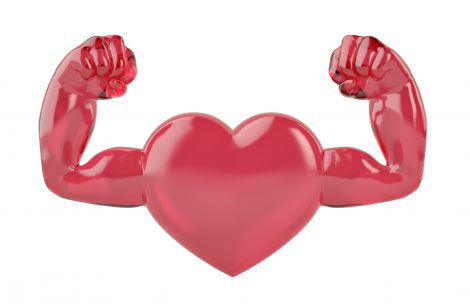Because humans require large amounts of energy to survive, we would probably not exist without mitochondria at least in human form. These microscopic, rod-shaped structures give cells their power; they are like little generators or power stations. Mitochondria convert oxygen and nutrients into energy “currents” and are the reason complex animal forms like humans can breathe oxygen.
With about 5,000 per cell, your heart has the most mitochondria cells than any other organ in the body. It makes sense the heart would have the most since it’s the hardest working bodily organ. The liver in comparison has about 1,000 to 2,000 mitochondria per cell.
When the heart is damaged by congenital heart defects, coronary artery disease, or cardiac arrest, the mitochondria and its mitochondrial DNA are often injured. In turn, the heart weakens and pumps blood less efficiently, the condition is called ischemia.
When ischemia occurs in the elderly or babies, the heart has a more difficult time of healing. For babies or young children, the mortality rate after cardiac arrest is over 40% because of damage to the mitochondria.
James McCully, Ph.D. for decades has been focused on the idea of using mitochondria to improve heart function after being damaged. In his laboratory working with animals, he worked on perfecting a method to quickly extract healthy mitochondria from cells, purify them, and insert into damaged heart muscles. Recently, at Boston’s Children’s Hospital, his idea came to fruition when the first mitochondrial transplantations took place.
For those whose bodies are unable to recover on their own from cardiac arrest, they need to go on a heart-lung bypass machine. The extracorporeal membrane oxygenation (ECMO) machine restores blood flow and oxygen to the heart. The longer a patient is on the ECMO, the less chance of recovery they have.
Two and half year-old Avery Gagnon became one of the first humans to have a mitochondrial transplant. Avery was born in December 2015 with complex congenital heart disease. At Boston’s Children’s hospital, she had multiple open-heart surgeries in the first few months of her life. She was dependent on the ECMO to keep her alive because of ischemia and the resulting damage to her mitochondria cells. With each passing day, her chances of survival looked slim.
Dr. McCully along with heart surgeon Dr. Sitaram Emani proposed the transplant to Avery’s parents. Her parents agreed to the procedure. About the decision, Avery’s mom said, “‘We understood that the risks were minimal considering the larger risks Avery was facing… We decided to go through with it.’”[1]
“Within 48 hours of mitochondrial transplantation, we start to see heart function improve in our patients,” said Emani. “By day four, their heart function has nearly normalized.”
Purified mitochondria from Avery’s cells were injected into the damaged areas of Avery’s heart muscles. The transplant was a success for Avery; her heart function improved immediately. She was even able to come off the ECMO machine that has kept her alive up until now. And she is doing well.
Dr. McCully said initially the mitochondria provide extra sources of energy for the heart. And over time, the mitochondria will move into the cells and provide other functions. One of the main concerns about the transplantation causing cardiac arrest because of a needle being inserted into the muscle has proved unfounded. Injecting the heart muscle hasn’t created any complications in the operations the doctors have performed.
Doctors Emani and McCully have completed at least 11 mitochondrial transplantations in children with promising results. While recovery time was longer for a few of the patients, most of them have been able to come off the ECMO machine.
The doctors have their sights on additional uses for mitochondria transplantation. They would like to see the treatment expand to people of all ages who have undergone heart operations. Also, they theorize that other organs, such as liver, lungs, brain, and the kidneys, affected by ischemia may benefit mitochondria transplantation. In addition, they want to develop a method where the mitochondria can be delivered through the veins so that the procedure is less invasive.
Mitochondrial transplantation from this initial venture looks to be a healing therapy full of promise. It will help people recover more quickly and fully from many health conditions. This first run of treatments appears to be only the beginning of what mitochondrial transplantation can do.
Purified mitochondria from Avery’s cells were injected into the damaged areas of Avery’s heart muscles. The transplant was a success for Avery; her heart function improved immediately. She was even able to come off the ECMO machine that has kept her alive up until now. And she is doing well.
Dr. McCully said initially the mitochondria provide extra sources of energy for the heart. And over time, the mitochondria will move into the cells and provide other functions. One of the main concerns about the transplantation causing cardiac arrest because of a needle being inserted into the muscle has proved unfounded. Injecting the heart muscle hasn’t created any complications in the operations the doctors have performed.
Mitochondrial transplantation from this initial venture looks to be a healing therapy full of promise. It will help people recover more quickly and fully from many health conditions. This first run of treatments appears to be only the beginning of what mitochondrial transplantation can do.
References:
- Heart Attack or Sudden Cardiac Arrest: How Are They Different? (March 15, 2018). Retrieved from https://www.heart.org/HEARTORG/Conditions/More/MyHeartandStrokeNews/Heart-Attack-or-Sudden-Cardiac-Arrest-How-Are-They-Different_UCM_440804_Article.jsp.
- McAlpine Kat J. Hearts get a boost from mitochondrial transplantation. (July 10, 2018). Retrieved from https://vector.childrenshospital.org/2018/07/hearts-get-a-boost-from-mitochondrial-transplantation/.
- McAlpine, Kat J. How mitochondrial transplantation saved Avery’s life (July 10, 2018). Retrieved from https://thriving.childrenshospital.org/mitochondrial-transplantation-avery/.
- Mitochondria. Retrieved from https://micro.magnet.fsu.edu/cells/mitochondria/mitochondria.html.
- McAlpine, Kat J., How mitochondrial transplantation saved Avery’s life, July 10, 2018. Web.
- McAlpine Kat J., Hearts get a boost from mitochondrial transplantation, July 10, 2018. Web.

